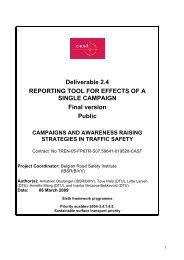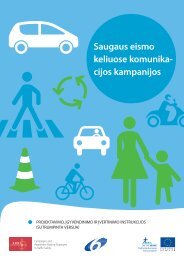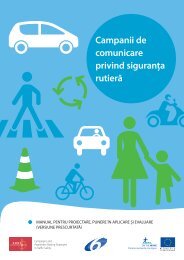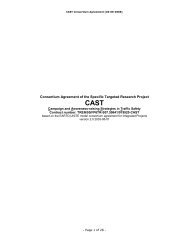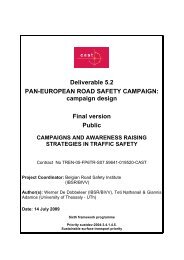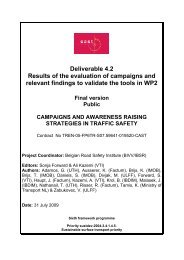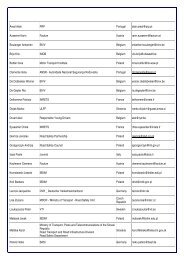Deliverable D 1.3 RESULTS OF META-ANALYSIS ... - cast-eu.org
Deliverable D 1.3 RESULTS OF META-ANALYSIS ... - cast-eu.org
Deliverable D 1.3 RESULTS OF META-ANALYSIS ... - cast-eu.org
You also want an ePaper? Increase the reach of your titles
YUMPU automatically turns print PDFs into web optimized ePapers that Google loves.
Campaigns and awareness raising strategies in traffic safety — <strong>Deliverable</strong> D-1.1campaign effects, and the reasons for its existence. Do target populationsbecome more resistant to safety campaigns over time (campaign fatigue?) ordo other cultural or social effects come into play as initial levels of desiredbehaviour increase in the target population?Links between campaign effects on accidents and behaviourOne might have expected that meta-regression would identify a single set ofcampaign factors that are responsible both for successful changes in roaduser behaviour and accidents. One might go further and predict that that sameset of factors should be more strongly related to behavioural outcomes. Wecontend, however, that the two models presented in CAST should not beconsidered in this way for several reasons.Firstly, the accident effects used to generate the accident model are ofcampaigns whose themes are not only seatbelt use, but drink-driving,speeding, general road safety behaviours and so on. Change in each of thesebehaviours may be more or less susceptible to influence by differentcampaign factors. For instance, on-road messages might be less likely todiscourage drink-driving, which begins off-road (presumably), than speedingor seatbelt wearing.The situation is further complicated by the fact that the same percentage andintensity of change in each of these behaviours will have different effects onaccident counts.Secondly, as we have noted, the models are generated from groups of studiesthat differ systematically. For example, studies using seatbelt effects tend,more than those using accident counts, to evaluate campaigns carried out onrestricted populations. Restricted populations are amenable to differentmeasures, and can be influenced in different ways.Further explore on-road delivery methodsAs we have noted, on-road delivery was consistently effective according tomultivariate analysis. Since the variable comprises billboard, variablemessage sign and fixed message sign use, it would be worth exploring furtherto see whether active feedback is simple delivery of a message in a drivingcontext that is important. The use of roadside posters or posters mounted onpublic transport could be added to expand the variable.Addressing social norms, emotional-rational content, and clearidentification of target group could also be importantSubgroup analyses in this report give insight into some factors that we wer<strong>eu</strong>nable to enter into meta-regression analysis, due to the lack of descriptivedata available in the evaluation studies. As we have said, those campaigns inour sample that identify target groups, address the social norm, or combineemotional and rational information, are associated with better accident andseatbelt use outcomes. The use of a reward, or a pledge system in whichpeople ‘pledge’ to change behaviour, are also associated with better seatbeltuse outcomes, as is consultation with a sample of the target for thedevelopment of campaign content. Although it should be remembered thatthese associations were found when other factors are not controlled for, theyremain potentially important. Just because they could not be included as116



